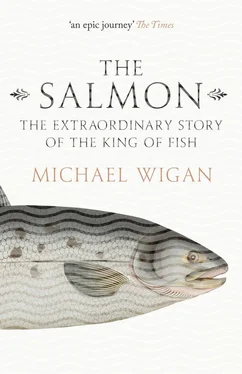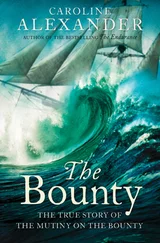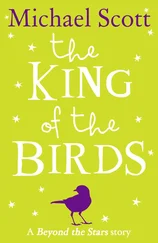The point about the prodigious runs of salmon into western Pacific rivers is more significant, though. The salmon runs dictated human settlement; this can be shown compellingly. No one has applied this information to settlement history in Western Europe. Here the Atlantic salmon, not the Pacific species, was the bonanza of protein delivered by migratory evolution. It is known that the Phoenicians netted tuna in the open sea two thousand years ago. Anyone capable of doing that, and capturing very large fish which were also the fastest swimmers in the sea, could with comparatively little effort have trapped salmon. And they did.
Take the Pacific coast first. In his 2011 book comparing the New World and the Old World, entitled The Great Divide , Peter Watson examines the effects of a great climate shift. From around 6000 BC sea levels began to stabilise. Glaciers had been pouring fresh water into the seas, and land had been rising as the weight of ice lifted. This process eventually levelled out. Vast shoals of salmon began to swim up the pristine rivers. A harvest of fish arrived on the doorstep of tribes on river-mouths and it came every year, regular as the turning season.
Peter Watson’s evidence comes from the fish bones in riverside human settlement remains. There, human skeletons show signs of arthritis consistent with a diet consisting predominantly of fish. From about 3,000 BC shellfish were added to the menu. Middens grew in size and it appears clans and tribes began to become more permanent and less peripatetic. Cemeteries mark places where tribes wished not only to lay their ancestors’ bones, but also places to which they lay claim.
Peter Watson’s theory is that the New World, blessed with abundant game and a wagon-train of protein in the form of Pacific salmon arriving before the onset of winter to stock the larders, had no need to evolve and develop agriculture, as had happened in the Old World. Where societies in Asia and Europe lived on cereals and domesticated animals, in the Americas people were graced with abundant wild animals for food. Chief was salmon; north-western cultures used flounders, herring, cod, sturgeon and small oil-rich fish called eulachon too, but most important of all was salmon.
The key to the harvest is the nature of tidal rivers and migrating behaviour of salmon. When the tide fills a river-mouth the fish ride in on it, holding on to the top layer so as not to scrape their stomachs on stones. This way they ascend the river to ascertain whether to continue in the freshwater environment or return to the saltwater and wait for a better moment. But as they return the tidewater level is falling. There is less water to swim in. That is when a river-bed weir structure which had been below water level a few hours earlier suddenly becomes a barrier. There is no escape over the top of it and the unimpeded water flows back through small spaces in the weir. All that is left behind is the fish. They can then be speared or caught in dip-nets, or in a manner of other ways removed from the water. Easy as pie.
There is nothing smart about this: I have seen the same thing happening in Scotland about thirty years ago on the River Ericht, a tributary of the Tay. Stone Age isn’t dead! Village boys ran about amongst the rocks as the water levels fell during a dry spell, spearing and catching salmon marooned in pools. Some of them had lamps and flares the better to see the fish as dusk drew in. That scene, long ago called ‘burning the water’, could have been taking place at any point in the last thousand years. Technically illegal at the time, the occasion pre-dated the era when salmon were accepted as being rare and in need of protection from this primitive-style capture.
Yet the riotous melee had an atmosphere of folk revelry and abandonment to primal energy which somehow stirred ancient memories. Anyone prone to get too sniffy about inappropriate salmon-catching should be reminded that some late-eighteenth-century landowners in New England, unversed in the then-unknown delights of rod-and-line fishing, travelled distances to the Connecticut River to get their fun from salmon-spearing and gaffing salmon leaping at waterfalls.
In the Pacific Northwest the background to salmon capture was quite different. There the salmon was holy and the run was a phenomenon upon which survival hung. Unsurprisingly, the ingenuity, artistry and practical neatness of some of the artefacts developed to capture and process the fish harvest from the sea were astonishing. Salmon were the lifeblood of existence for these people and their fishing culture reflected it. The most famous artwork from the Pacific Northwest is from the Haida Indians, and some of their resplendent work consists of images of fish. Salmon equalled tribe survival and the cultural acknowledgement of this is a feature of the history of the north-west.
Catching salmon was taken to a level of high art in a practical sense. Cedar bark was twined into nets and split cedar boughs were used to make nets and traps. Cedar was deployed too to make lashings for constructing lattices for stopping advancing fish, and wild cherry was tough enough for attaching shafts to nets and fish-spears. Flexible boughs of hemlock and spruce were twisted into fish-traps formed like tunnels in varied designs.
The native people were assiduous in the harvest of their prime resource. The techniques and structures were impressively elaborate. In some of the fish enclosures constructed to hold fish as the tide receded, white clam shells paved the floor, better to show to those peering down what fish were held there. There were lattice mazes with intermittent posts driven into the tidal estuary to snare salmon drifting on the tides; looking for a way out, the salmon swam further in. Different designs were used for varying stream flows and different woods were separated into functions suited to their characteristics; for instance, willow was used for major weirs, being strong and flexible and abundantly available. Stakes held their position, being pointed at the bottom and driven into the stream-bed. On the longer weirs the fishermen built spearing platforms in tripod shapes which enabled them to spot the quarry. Spears were subtly designed with stop-butts to prevent the pointed spear sections being damaged on the bottom.
Plant knowledge had progressed far on this well-endowed coastline. The Indians discovered that the stinging nettle, which grew over head height in those parts, had a property which could be used for salmon harvest. The stalks were cut, dried, peeled, beaten, shredded and then spun into a two-strand twine of exceptional strength. The wood and bone spindles used to do this were in use up to the present time.
In preparation for her brilliant illustrated study, Indian Fishing , British Columbian writer Hilary Stewart tried out these techniques herself. Using plants and different woods she constructed weirs and traps and spears and every tool connected to the salmon harvest. She found it took time and skill to replicate the old toolkits – but they worked. In Europe the same knowledge existed and nettles were considered to make stronger twine than flax – in fact the word ‘net’ derives from nettle. Cedar and willow bark were materials for net construction too. The hoops of nets might be made of bent vine maple.
The north-west Pacific peoples used only materials they had at hand. There were no imported or traded tools or materials. Anthropologists today might term their salmon capture ‘organic’. Looking back from where we are now there is something delightfully clean and satisfying about a food provision entirely serviced from the clever utilisation of local plants. Thinking further afield, there are few societies of which this remained true until recent time. The Inuits in the Arctic are an example, and there may be others in Arctic Russia, but on the bigger landmasses, where travel in any direction was physically feasible, there are few. There were the northern Saami and variously named reindeer-herders of the Asian tundra and taiga who relied almost exclusively on reindeer. Generally, though, only societies on the rim of the habitable zone were reliant on a single migratory animal.
Читать дальше












